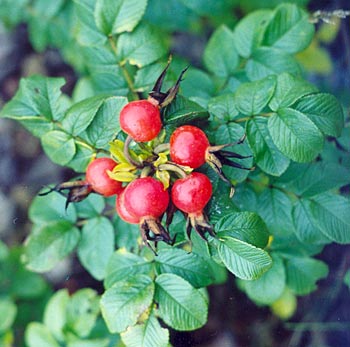Relatives
Rosa rugosa Thunb. - Rugosa rose
Taxonomic position.
Family Rosaceae Juss. genus Rosa L.Morphology and biology.
Deciduous shrub, 1.5 (2.5) m tall, with thick (up to 3-4 cm in diameter at the base) branches densely covered with numerous variegated thorns, from straight, strongly broadened at the base to thin and needle-shaped. Young shoots are densely pubescent and covered with numerous thorns. Leaves are alternate, compound, imparipinnate, 5-15 (20) cm in length, consisting of 5-9 leaflets. Leaflets are 2-5 cm long, elliptic or ovate, compact, shortly dentate; the upper surface is rugose, glossy, naked, while the underside is densely pubescent (especially along the veins), usually with abundant short-stemmed glandules. Petioles and awns of the leaves have extremely strong pubescence. Pedicels are 1-2.5 cm long, varying from naked to glandular pubescent. Sepals are entire, on the outside often pubescent and glandular. Flowers are single or grouped in 2-6 (7). Corollas are dark-pink, less frequently white, 4-10 (13) cm in diameter. The fruit is a multi-nut inside an effuse hypanthium, which becomes fleshy and forms the cover of a pseudocarp. Fruits are globular, 20-30 mm in diameter, red, pulpy, naked, or occasionally prickly. This species is entomophilous. It is ornito-, zoo- and hydrochore. It is propagated by seed, layers and summer cuttings. Blossoms from the end of June until the first frosts; fruits ripen in late August-first half of September. Chromosome number: 2n=14.Distribution.
This species grows in the Russian Far East (coastal areas of the Maritime Region, Kamchatka, Sakhalin, Kurile and Shantar Islands), China, Korea and Japan.Ecology.
Grows in groups or forms thickets on sandy and sand-and-pebbly seashores, littoral meadows, and sometimes penetrates inland along river valleys. It is a mesophyte. It is light-demanding.Utilization and economic value.
This species is used as a food, melliferous, medicinal and ornamental plant. Fruits are distinguished for high content of ascorbic acid and carotene. It is recommended for utilization in landscaping, well adapted to pruning. It develops quite a few ornamental forms.Reference citations:
Kharkevich S.S., ed. 1996. Vascular plants of the Soviet Far East. V. 8. Leningrad: Nauka. 234 p. (In Russian)Koropachinskiy I.Yu., Vstovskaya T.N. 2002. Woody plants of the Asian part of Russia. Novosibirsk: Publishing House of SB RAS, Branch "Geo". 362-364 p. (In Russian)
Sokolov S.I., Svjaseva O.A., Kubli V.A. 1980. Areas of distribution of trees and shrubs in the USSR. V. 2. Leningrad: Nauka. 98 p. (In Russian)


